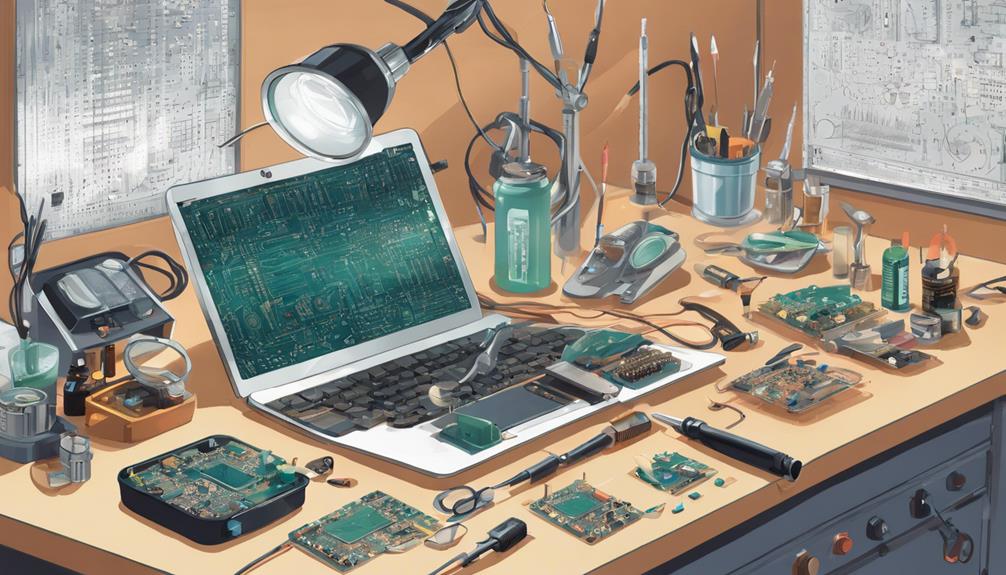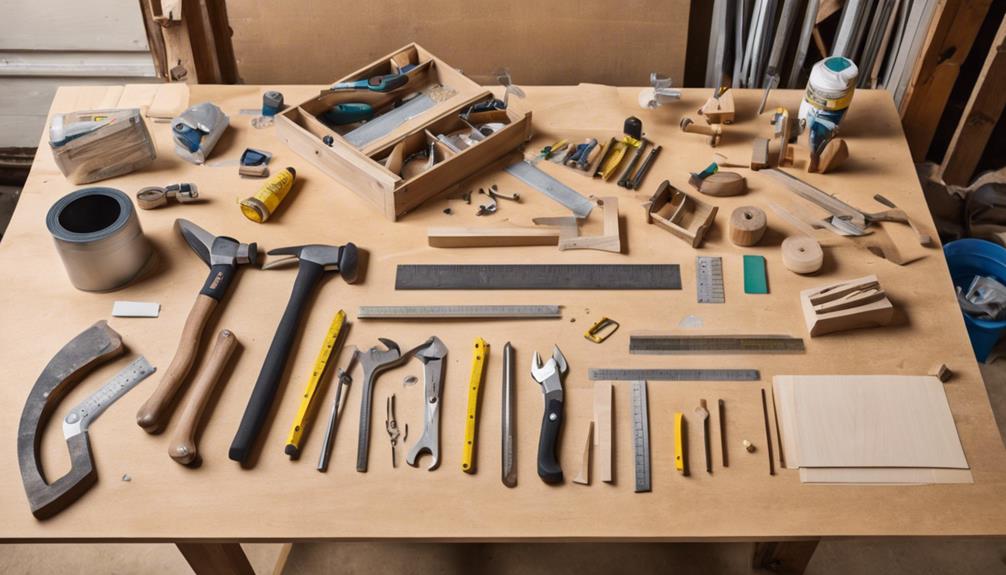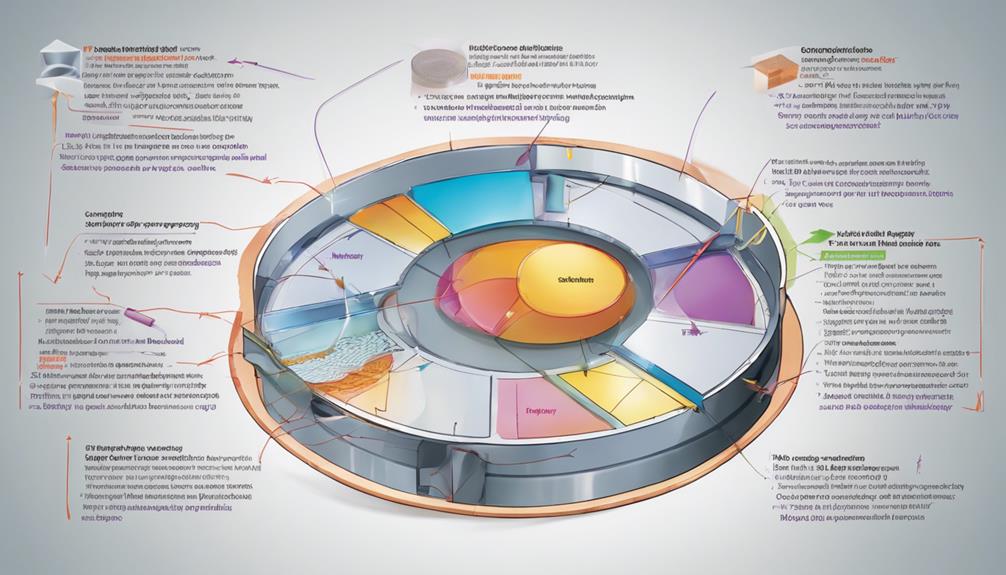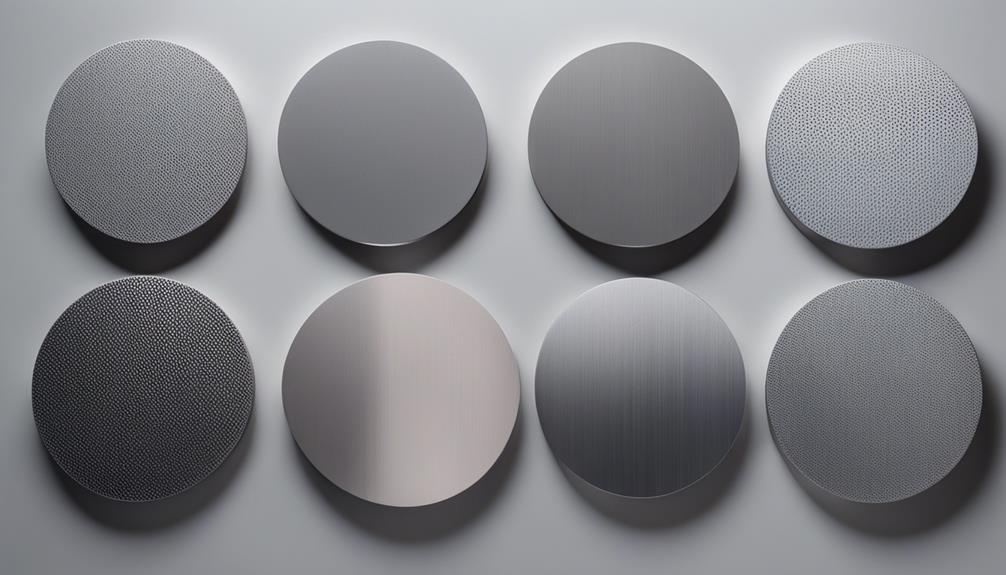For beginners, mastering fabrication techniques is essential for producing high-quality printed circuit boards (PCBs). Five essential techniques to master include chemical etching for precise circuit traces, laser cutting for intricate designs, PCB milling and drilling for complex circuits, solder mask and silk screen for enhanced reliability, and PCB tinning and coating for improved performance. Each technique requires attention to detail and precision to achieve best results. By grasping these fundamental techniques, beginners can take the first step towards creating reliable and efficient PCBs, and exploring further will reveal even more insights into the world of fabrication.
Key Takeaways
- Mastering chemical etching with ferric chloride or ammonium persulfate solutions is essential for creating precise circuit traces.
- Laser cutting offers unparalleled accuracy for intricate designs and complex shapes in PCB fabrication.
- PCB milling and drilling are crucial techniques for creating intricate circuit traces and component mounting holes.
- Applying solder mask and silk screen enhances the reliability and functionality of PCBs by preventing shorts and corrosion.
- Tinning and coating techniques protect copper traces from oxidation and improve solderability, ensuring reliable PCB performance.
Chemical Etching for PCBs
Chemical etching, an essential step in the fabrication of printed circuit boards (PCBs), involves selectively removing unwanted copper to create precise circuit traces. This process is vital in creating functional electronic circuits, as it allows for the creation of intricate pathways for electrical signals to flow.
To achieve precise etching results, beginners can master the process by using ferric chloride or ammonium persulfate solutions to etch PCBs. It is essential to follow safety precautions, including wearing gloves, goggles, and working in a well-ventilated area, to avoid exposure to hazardous chemicals.
When etching small pieces of copper, precise timing and agitation of the etchant are required to fabricate accurate circuit traces. Careful monitoring of the process is necessary to achieve clean and precise etching results.
Laser Cutting for Precision

Beyond the sphere of chemical etching, laser cutting emerges as a precision fabrication technique, offering unparalleled accuracy and speed in metal fabrication. This technique uses a focused laser beam to cut materials with high precision and accuracy, making it ideal for intricate designs, detailed patterns, and complex shapes.
Some key benefits of laser cutting include:
- Clean edges: Laser cutting produces clean edges without the need for additional finishing, reducing post-processing time.
- Fast and efficient: The process is fast, efficient, and computer-controlled, allowing for repeatable and consistent results.
- High precision: Laser cutting offers unparalleled accuracy, making it perfect for intricate designs and complex shapes.
Beginners can explore laser cutting services or affordable desktop laser cutters to practice and master this technique. With its precision and speed, laser cutting is an essential fabrication technique for beginners to master, opening up new possibilities for creative and innovative projects.
PCB Milling and Drilling

In the field of printed circuit board (PCB) fabrication, PCB milling and drilling emerge as essential techniques for creating complex electronic circuits with precision and accuracy. These techniques enable the creation of intricate circuit traces and component mounting holes with precision, making them indispensable for modern electronic devices.
PCB milling, a precise method of removing copper from a board, utilizes a CNC machine to create circuit traces. Beginners can start with simple PCB designs and progressively move to more complex projects, refining their skills.
Drilling, on the other hand, involves creating holes in the PCB for component mounting using specialized drill bits.
Accurate measurements and precise tool settings are crucial for successful PCB milling and drilling. Designing PCB layouts using software like Eagle, KiCad, or Altium Designer can facilitate the process.
Solder Mask and Silk Screen

An essential step in the fabrication process, the application of solder mask and silk screen enhances the reliability and functionality of a printed circuit board (PCB) by protecting copper traces and providing important labeling information.
The solder mask, a protective layer applied over the copper traces, prevents shorts and corrosion, ensuring the PCB's longevity.
Meanwhile, the silk screen layer, composed of ink applied on top of the solder mask, labels components, logos, or instructions, facilitating identification, polarity indication, and assembly instructions.
To achieve a professional finish, mastering the application of solder mask and silk screen is vital. Here are three key considerations:
- Application methods: Solder mask can be applied using silkscreen printing or liquid solder mask with a UV exposure unit, while silk screen labels require precise ink application.
- Material selection: Choose high-quality solder mask and silk screen materials to maintain durability and readability.
- Precision is key: Ensure accurate registration and alignment of the solder mask and silk screen layers to uphold the PCB's overall quality.
How can I apply PCB assembly techniques to fabricate electronic components as a beginner?
As a beginner, learning the PCB assembly process comprehensive guide is crucial for fabricating electronic components. Start by familiarizing yourself with the necessary tools and materials. Understanding soldering techniques and safety measures are also essential. Practice with small projects to gain hands-on experience and improve your skills.
PCB Tinning and Coating

PCB tinning and coating is an essential fabrication step that enhances the reliability and performance of a printed circuit board (PCB) by protecting its copper traces from oxidation and improving solderability.
This process involves coating the surface of the PCB with a thin layer of solder, which not only prevents oxidation but also enhances the overall durability of the board.
To achieve a uniform coating, it is important to apply flux, heat the PCB, and evenly spread the solder.
Proper tinning techniques are vital, and this includes using the right soldering iron temperature to guarantee the solder flows smoothly across the PCB surface.
A well-tinned PCB also aids in the assembly process by making it easier to solder components onto the board.
By mastering the art of PCB tinning and coating, beginners can greatly improve the quality and reliability of their fabricated PCBs.
With the right techniques and attention to detail, this essential fabrication step can be accomplished effectively, leading to enhanced PCB performance and durability.
Frequently Asked Questions
What Are the Three Main Fabrication Techniques?
The three primary fabrication techniques are cutting, bending, and assembling.
Cutting involves shaping metal into desired sizes and shapes using tools like shears, saws, or plasma cutters.
Bending reshapes metal through folding, rolling, or hammering to create angles or curves.
Assembling joins metal pieces together using methods like welding, riveting, or bolting to form the final product.
What Are the 9 Ways to Better Fabrication?
One potential obstacle to mastering fabrication techniques is the misconception that it requires extensive experience. However, with dedication and practice, beginners can rapidly improve their skills.
To better fabrication, nine key strategies can be employed:
- Precision measuring
- Accurate cutting
- Effective material selection
- Efficient workflow planning
- Mastering various joining techniques
- Leveraging specialized tools
- Optimizing workshop organization
- Minimizing material waste
- Continuous skill refinement through online tutorials and community engagement.
What Are the Basics of Fabrication?
The fundamentals of fabrication entail understanding metal behavior. This involves leveraging basic tools like hammers and snips and developing hands-on skills through projects.
Mastering metal manipulation in a vise, bending techniques, and utilizing clamps and jigs for precision are essential.
What Is the First Step in Fabrication?
Understanding the metal's properties is the first essential step in fabrication. It's like being a master chef, where knowing the ingredients is key to a perfect dish.
Without grasping how metal responds to heat, force, and manipulation, even the most skilled fabricators will struggle. Recognizing the metal's strengths, weaknesses, and reactions enables fabricators to predict and control the outcome, laying the foundation for successful projects and avoiding costly mistakes.


